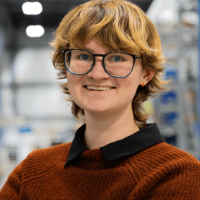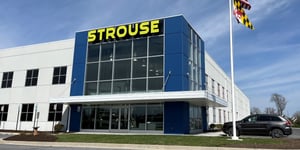A few weeks ago, I was in Washington, D.C., for the Cherry Blossom Festival, and my friend and I thought we’d stop and get cold drinks from a nearby food truck.
I didn’t think much of it when I ordered mango tea, but as the man began pouring me a cup of plain coffee creamer, I realized we’d made a terrible mistake.
Thinking back to the incident, I can now spot the dozens of warning signs I’d ignored. For starters, every other truck had a long line, while this ice cream truck was empty. However, in the simmering heat, I trusted them simply because they’d written “TEA” on the side in big, bold letters.
Ordering from a flexible material converter without seeing the facility is like buying food from a mysterious food truck: you’ll get something, but it might not be exactly what’s written on the menu.
Facility tours can be a priceless opportunity to see the machines up close and listen to your converter explain how they use different processes. At Strouse, tours are critical to fostering customer relationships by demonstrating our existing capabilities.
Knowing the benefits of touring your manufacturer’s facility will allow you to determine when facility tours are necessary and how to get the most out of future tours.

5 Benefits of Touring Your Manufacturer’s Facility
Touring your manufacturer’s facility is more than just establishing trust in their capabilities, it’s also a way to further your connections and generate future project ideas.
These benefits of touring a manufacturing facility will demonstrate whether it’s worth the cost to your company:
BENEFIT #1: VERIFY MACHINES AND EQUIPMENT
“Yeah, we can make that for you,” says some guy you met online.
For all you know, this contact operates a single die cut machine out of his garage. Yet, when you invest in another company for your critical projects, you’ll want to have the utmost faith in their ability to deliver on time.
There’s a considerable difference between owning a single rotary die cut press versus multiple, and depending on where you are in the process, your project requires different capability levels. Not to mention, many businesses plan to scale up their production early.
Will you know whether the equipment they’re showing you is up-to-date rather than over a decade old? If you want to inspect a converter’s equipment, send one of your technical experts to check.
The company members you send on the tour will likely depend on where you are in the cycle. For example, if you’re designing for current projects, it could be helpful to bring your technical team. Meanwhile, if you already have a product planned, you might want to include your logistics or purchasing team.
Verifying the machines and equipment of a converter is the first step to checking their capability claims and building trust in the legitimacy of their business.
BENEFIT #2: OBSERVE THE CONDITION OF THEIR FACTORY
Nobody wants their parts built in filthy conditions, yet many people order from manufacturers without ever seeing the inside of their factory.
For certain products, cleanliness is a much higher priority than for others. For instance, medical tape, bandages, and other products should be produced and stored in a sterile environment.
When walking through the factory, consider overall cleanliness, organization, material storage, safety measures, and waste disposal. Observe the condition of their factory, including their inventory, to determine whether your contact can safely store your materials and products.
Supply chain issues are commonplace in the manufacturing industry, and your converter might be unable to compete if it can’t order and store enough material to minimize the impact of supply chain disruptions.
Lastly, ask if your converter has immediate expansion plans. It could be a good sign if they’re building, renovating their facilities, or actively adding members to their team. If your converter is steadily progressing as a company and becoming a leader in their respective field, this has positive implications for the work they’ll be doing for you.
BENEFIT #3: MEET WITH YOUR CONTACTS
Meeting your contacts in person is vital for building trust and understanding how they operate and manage your project. It also allows you to form a better relationship and rapport.
Are they taking your project seriously? How have they handled the information you’ve presented them with so far? Do they ask questions about your current work and personalize the tour?
You can gauge a great deal about a company's culture based on the employees’ willingness to offer clear, insightful answers to your questions. In addition, it’s worth considering who you come into contact with on tour.
Are you directly communicating with somebody who can answer your more technical questions, or do they leave you hanging?
Touring a facility also lets you observe a company’s work environment and how the workflow is set up. While this might seem like a minor detail, it provides insight into their operations and inspires questions related to inter-team coordination.
Understanding how a potential partner operates may alter the way you coordinate, so it’s worth noting how the different teams are spread out.
Is the factory located in a separate building? You may need to confirm whether this business is the one responsible for building your part or if they’re outsourcing engineering and labor.
BENEFIT #4: INSPECT THEIR PRODUCTION OPERATIONS
Receiving samples in the mail is all well and good, but it’s different from seeing a converter build parts in real-time.
Watching rolls of material become products as part of a 1-pass production process will confirm that the machines are operational and that a converter knows how to set them up (which is arguably one of the most difficult aspects of flexible material converting) and build parts daily.
BENEFIT #5: REFLECT ON YOUR OWN PROJECT
Touring a manufacturing facility causes customers to reflect on their own project needs.
Firstly, you can rest assured that any product information you reveal will be strictly confidential if your converter suggests a mutual NDA. Strouse insists upon a mutual NDA before anyone enters our facilities to preserve the confidentiality of our processes and protect the details of any product, process, or material information you wish to discuss.
At the end of the day, the question is: what are YOU hoping to get out of this? If you’re willing to travel to see our facility, we want to make sure you get to speak with whomever you’re hoping and see what you’d like.
Secondly, if you’re hoping to make the most of your tour, it’s useful to warn your converter and let them know about your project or the capabilities you want to see. You might be worried that mentioning a specific ability will narrow a converter’s focus too much. From our perspective, it simply gives us a more precise idea of what to show you and how to frame our conversations to make them more useful to you.
Even if your tour guide focuses on specific capabilities, sometimes just seeing the other machines and hearing about your options can spark ideas for your product or manufacturing process.
Should I Tour My Manufacturer’s Facility?
No matter the outcome, you’ll always have a better idea of whether you should work with a particular manufacturer after touring their facility.
In fact, even if you’ve been to a facility before, it can be beneficial to return again every few years to discuss your current projects, witness the changes they’ve undergone, and guarantee your converter still follows good manufacturing practices.
The main downside to touring a manufacturer’s facility is figuring out when a tour is necessary and potentially wasting time and travel costs to visit a nonviable option.
If the cost of travel is too much, or you don’t have enough time, there are other ways to qualify the legitimacy of a converter. For instance, you could look online at reviews to see what other people are saying or utilize Google street view to observe the appearance of their address and scope out its size.
There are three main outcomes of taking a factory tour:
- The manufacturer has your desired equipment and capabilities
- They DON’T have your desired equipment and capabilities
- There are some capabilities, but you want to find a better fit
If you can afford the travel costs, and you’re at the point of asking the question, “Should I tour this facility?” the answer is probably yes, you should request a tour.
Every manufacturer has limitations, and touring their facility is a straightforward way to visit, ask questions, and better understand where they focus primarily and how they’re expanding in the current market.
Are you interested in witnessing Strouse’s manufacturing capabilities up-close and personal? Contact us to schedule a tour.






